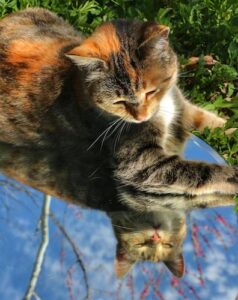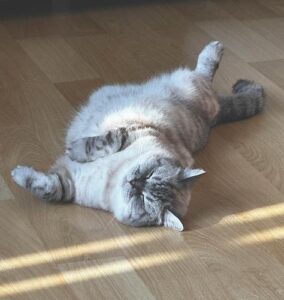
Any human who lives with a cat or two is bound to have noticed the special connection between cats and sunlight. Often, our feline friends look both majestic and relaxed when basking in the sun. They will also perform strange acrobatics and yoga-like stretches to fit into small sunny spots and will even move with their chosen ray of sunlight, adjusting their position or sleeping spot as the sun travels across the sky. But where does this love of sunlight come from?
1. Body Temperature
The first reason has to do with cat biology. Cats have a higher body temperature than humans, averaging around 102°F. Maintaining such a high temperature is hard work for the body, so nature has given the cat a convenient shortcut: the desire for a warm sleeping spot. If a cat can find a spot in the sun, on top of a radiator, or in a cozy cat bed, these external heat sources help the cat’s body preserve the energy it would otherwise have to spend generating the necessary heat. So, seeking out warmth is a survival mechanism genetically programmed into the cat.
 2. Restful Sleep
2. Restful Sleep
The second reason is tied to cat stress levels. A warm sleeping spot gives the cat an added sense of security. They instinctively know they are more vulnerable when sleeping and famously have an eye open and an ear on alert during most of their napping time. This is to avoid predator attacks. However, the increased vulnerability also comes from the slight drop in body temperature a cat experiences when sleeping. While asleep, a cat’s metabolism slows down, but choosing a warm spot to nap makes up for this loss in energy, which, in turn, gives the cat one less thing to worry about, thereby reducing stress and ensuring a more restful nap.
3. Ancestral Home
The third reason is rooted in cat history. Before cats decided to move in with humans, they lived in hot, desert areas. These living conditions are still reflected genetically in a heat tolerance that is much higher than that of humans. Our skin starts to feel pain around 113°F, while cats may be comfortable with temperatures as high as 125°F, explaining why our feline friends will stay in the sun on hot summer days, while we seek relief in front of our fans or air conditioners. Sensitivity to cold can vary slightly by breed. Siamese cats, for instance, often require more heat, whereas certain long-haired breeds may require less.
 Fun Fact
Fun Fact
In addition to the black color gene, many black or tuxedo cats are born with the gene for the tabby stripes. It means their coat has an underlying tabby pattern that is mostly invisible – unless you catch them while they sleep in the sun. Intense sunlight breaks down the black pigment in the fur, causing the hidden tabby pattern to appear. In other words, black cats don’t just stay warm in a sunny spot, they undergo a magical color transformation!
Remember
Cats generally have a higher heat tolerance, but they are not less sensitive to burns or overheating than we are. So, never let your cat sleep directly on a hot metal surface, and in the summer, always look out for symptoms of feline heat stroke. They include panting, drooling, fast breathing, and vomiting.
Author: Gunhild Jensen
Gunhild Jensen is the owner and founder of Smiling Kitty – a Stamford CT-based cat behavior business that offers expert help and guidance to cat owners around the world. Gunhild is a certified Cat Behaviorist and holds a degree in Advanced Feline Training and Behavior from the Animal Behavior Institute (ABI) in Durham, NC. She provides guidance on all things cat, including common behavior, home needs, nutrition, leash training, declawing, cat health, and more.
 Any human who lives with a cat or two is bound to have noticed the special connection between cats and sunlight. Often, our feline friends look both majestic and relaxed when basking in the sun. They will also perform strange acrobatics and yoga-like stretches to fit into small sunny spots and will even move with their chosen ray of sunlight, adjusting their position or sleeping spot as the sun travels across the sky. But where does this love of sunlight come from?
Any human who lives with a cat or two is bound to have noticed the special connection between cats and sunlight. Often, our feline friends look both majestic and relaxed when basking in the sun. They will also perform strange acrobatics and yoga-like stretches to fit into small sunny spots and will even move with their chosen ray of sunlight, adjusting their position or sleeping spot as the sun travels across the sky. But where does this love of sunlight come from? 2. Restful Sleep
2. Restful Sleep Fun Fact
Fun Fact


